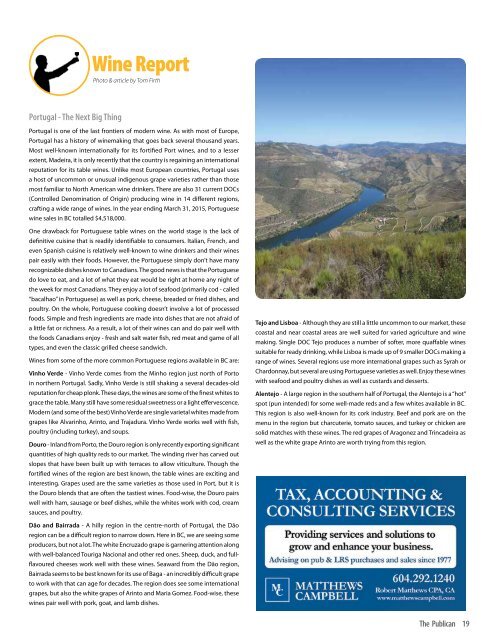Publican
pubspr16
pubspr16
You also want an ePaper? Increase the reach of your titles
YUMPU automatically turns print PDFs into web optimized ePapers that Google loves.
Wine Report<br />
Photo & article by Tom Firth<br />
Portugal - The Next Big Thing<br />
Portugal is one of the last frontiers of modern wine. As with most of Europe,<br />
Portugal has a history of winemaking that goes back several thousand years.<br />
Most well-known internationally for its fortified Port wines, and to a lesser<br />
extent, Madeira, it is only recently that the country is regaining an international<br />
reputation for its table wines. Unlike most European countries, Portugal uses<br />
a host of uncommon or unusual indigenous grape varieties rather than those<br />
most familiar to North American wine drinkers. There are also 31 current DOCs<br />
(Controlled Denomination of Origin) producing wine in 14 different regions,<br />
crafting a wide range of wines. In the year ending March 31, 2015, Portuguese<br />
wine sales in BC totalled $4,518,000.<br />
One drawback for Portuguese table wines on the world stage is the lack of<br />
definitive cuisine that is readily identifiable to consumers. Italian, French, and<br />
even Spanish cuisine is relatively well-known to wine drinkers and their wines<br />
pair easily with their foods. However, the Portuguese simply don’t have many<br />
recognizable dishes known to Canadians. The good news is that the Portuguese<br />
do love to eat, and a lot of what they eat would be right at home any night of<br />
the week for most Canadians. They enjoy a lot of seafood (primarily cod - called<br />
“bacalhao” in Portuguese) as well as pork, cheese, breaded or fried dishes, and<br />
poultry. On the whole, Portuguese cooking doesn’t involve a lot of processed<br />
foods. Simple and fresh ingredients are made into dishes that are not afraid of<br />
a little fat or richness. As a result, a lot of their wines can and do pair well with<br />
the foods Canadians enjoy - fresh and salt water fish, red meat and game of all<br />
types, and even the classic grilled cheese sandwich.<br />
Wines from some of the more common Portuguese regions available in BC are:<br />
Vinho Verde - Vinho Verde comes from the Minho region just north of Porto<br />
in northern Portugal. Sadly, Vinho Verde is still shaking a several decades-old<br />
reputation for cheap plonk. These days, the wines are some of the finest whites to<br />
grace the table. Many still have some residual sweetness or a light effervescence.<br />
Modern (and some of the best) Vinho Verde are single varietal whites made from<br />
grapes like Alvarinho, Arinto, and Trajadura. Vinho Verde works well with fish,<br />
poultry (including turkey), and soups.<br />
Douro - Inland from Porto, the Douro region is only recently exporting significant<br />
quantities of high quality reds to our market. The winding river has carved out<br />
slopes that have been built up with terraces to allow viticulture. Though the<br />
fortified wines of the region are best known, the table wines are exciting and<br />
interesting. Grapes used are the same varieties as those used in Port, but it is<br />
the Douro blends that are often the tastiest wines. Food-wise, the Douro pairs<br />
well with ham, sausage or beef dishes, while the whites work with cod, cream<br />
sauces, and poultry.<br />
Tejo and Lisboa - Although they are still a little uncommon to our market, these<br />
coastal and near coastal areas are well suited for varied agriculture and wine<br />
making. Single DOC Tejo produces a number of softer, more quaffable wines<br />
suitable for ready drinking, while Lisboa is made up of 9 smaller DOCs making a<br />
range of wines. Several regions use more international grapes such as Syrah or<br />
Chardonnay, but several are using Portuguese varieties as well. Enjoy these wines<br />
with seafood and poultry dishes as well as custards and desserts.<br />
Alentejo - A large region in the southern half of Portugal, the Alentejo is a “hot”<br />
spot (pun intended) for some well-made reds and a few whites available in BC.<br />
This region is also well-known for its cork industry. Beef and pork are on the<br />
menu in the region but charcuterie, tomato sauces, and turkey or chicken are<br />
solid matches with these wines. The red grapes of Aragonez and Trincadeira as<br />
well as the white grape Arinto are worth trying from this region.<br />
Dão and Bairrada - A hilly region in the centre-north of Portugal, the Dão<br />
region can be a difficult region to narrow down. Here in BC, we are seeing some<br />
producers, but not a lot. The white Encruzado grape is garnering attention along<br />
with well-balanced Touriga Nacional and other red ones. Sheep, duck, and fullflavoured<br />
cheeses work well with these wines. Seaward from the Dão region,<br />
Bairrada seems to be best known for its use of Baga - an incredibly difficult grape<br />
to work with that can age for decades. The region does see some international<br />
grapes, but also the white grapes of Arinto and Maria Gomez. Food-wise, these<br />
wines pair well with pork, goat, and lamb dishes.<br />
The <strong>Publican</strong><br />
19


